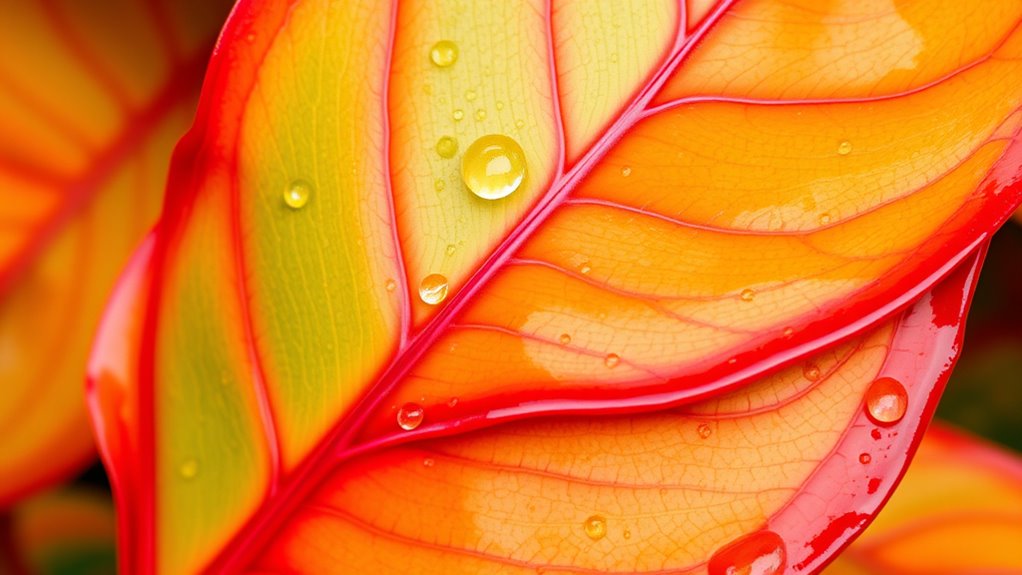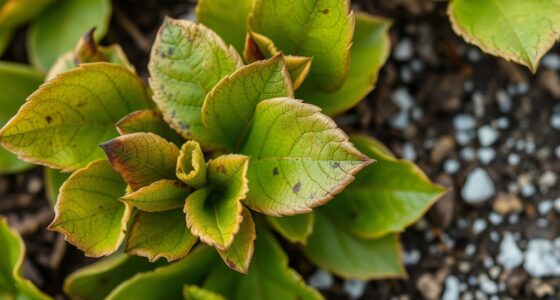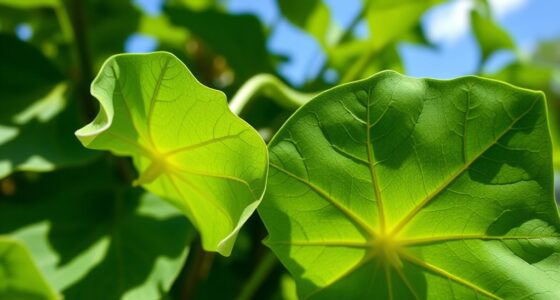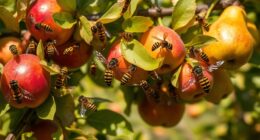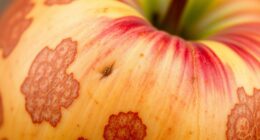If your Photinia’s leaves are curling and the red tips are fading or showing problems, it could be caused by environmental stress, improper pruning, or nutrient issues. Overwatering, pests, or fungal infections might also be factors. To restore its health and vibrant color, you’ll want to check your watering habits, prune correctly, and improve soil conditions. Keeping an eye on these problems helps, and exploring further will give you more effective solutions to keep your plant thriving.
Key Takeaways
- Leaf curl in photinia can result from improper pruning, poor soil, or over-application of chemicals causing stress.
- The red tip color change is natural but can be affected by sunlight, fertilization, and pruning practices.
- Yellowing or browning leaves indicate overwatering, poor drainage, or pest issues.
- Prevent leaf curl by using proper pruning, maintaining soil health, and ensuring consistent watering practices.
- Treat affected plants by removing damaged branches, improving soil, and monitoring pests to support recovery.
Understanding the Causes of Photinia Leaf Curl
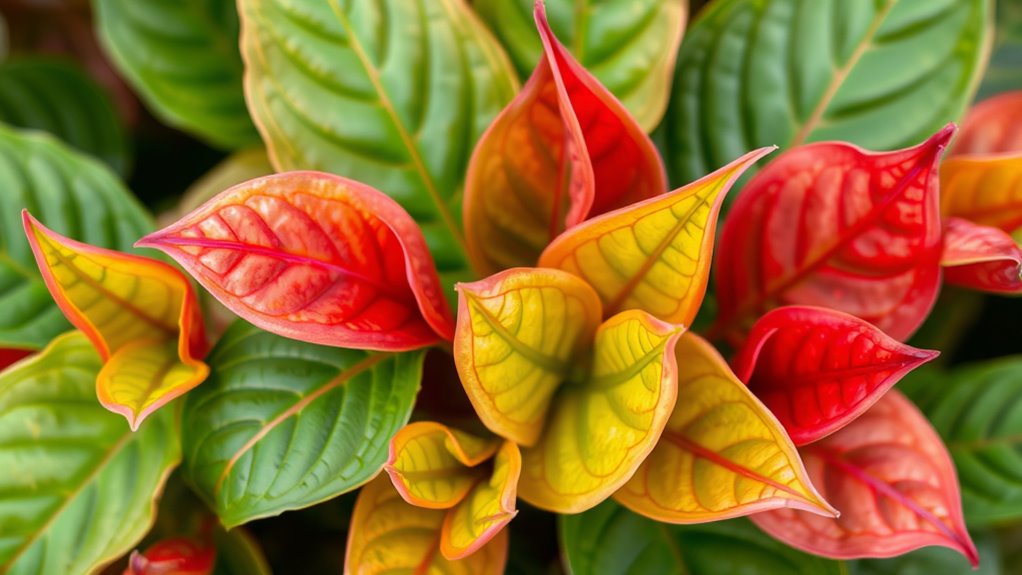
Understanding the causes of Photinia leaf curl is essential to effectively address the problem. One common factor is improper pruning techniques, which can stress the plant and make it more vulnerable to leaf curl. When pruning, always use sharp tools and avoid removing too much foliage at once, as this can weaken the plant’s defenses. Additionally, soil conditions play a significant role; poor soil amendments can lead to nutrient deficiencies or imbalances that cause leaves to curl. Ensuring your soil is well-amended with organic matter improves drainage and nutrient availability, helping the plant stay healthy. Proper paint application techniques, such as avoiding over-application or inconsistent spraying, can also reduce stress on the plant. By paying attention to proper pruning techniques and improving soil health through amendments, you can reduce stress on your Photinia and minimize leaf curl issues.
Adding plant health management practices can further support the overall resilience of your Photinia.
The Red Tip Phenomenon: Why It Happens
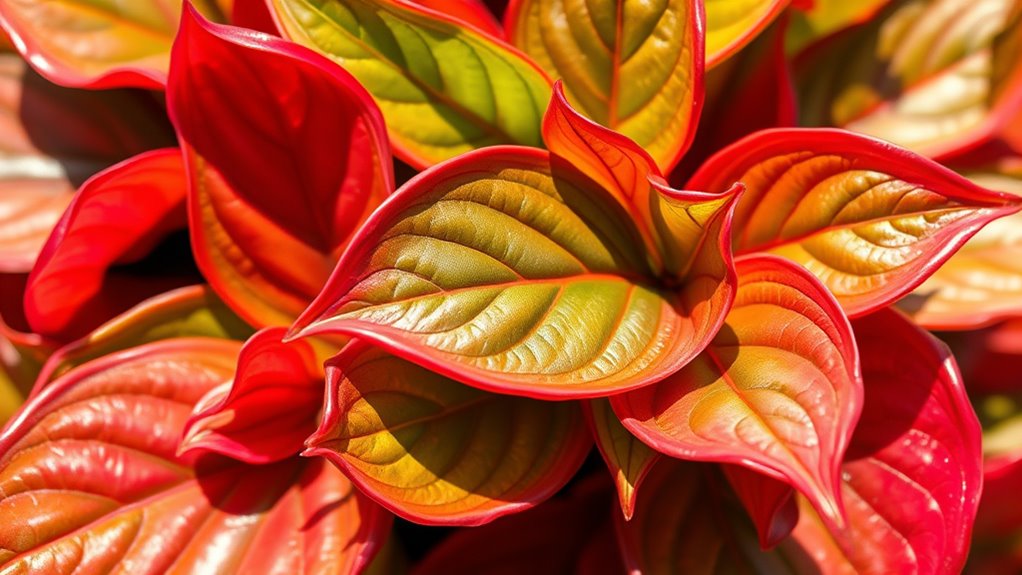
The Red Tip phenomenon occurs when the new growth on Photinia turns a vibrant red, creating a striking contrast against the green foliage. This color change is natural but can also be influenced by cultural practices and pruning techniques. To encourage red tips, you should:
- Ensure proper sunlight exposure, as it enhances red pigmentation
- Avoid over-fertilizing with nitrogen, which promotes lush green growth
- Use selective pruning to stimulate new red growth
- Maintain consistent watering to prevent stress that can affect coloration
- Be aware that Juice Cleansing benefits and practices share similarities with plant care strategies, emphasizing the importance of proper management for optimal results. Additionally, understanding Gold IRA Rollovers can help diversify your investment portfolio to support long-term financial health.
Understanding how these factors influence the Red Tip helps you manage your plant’s appearance. Proper cultural practices and strategic pruning promote healthy, vibrant red tips, making your Photinia a striking focal point in your landscape.
Identifying Signs of Stress and Disease in Photinia
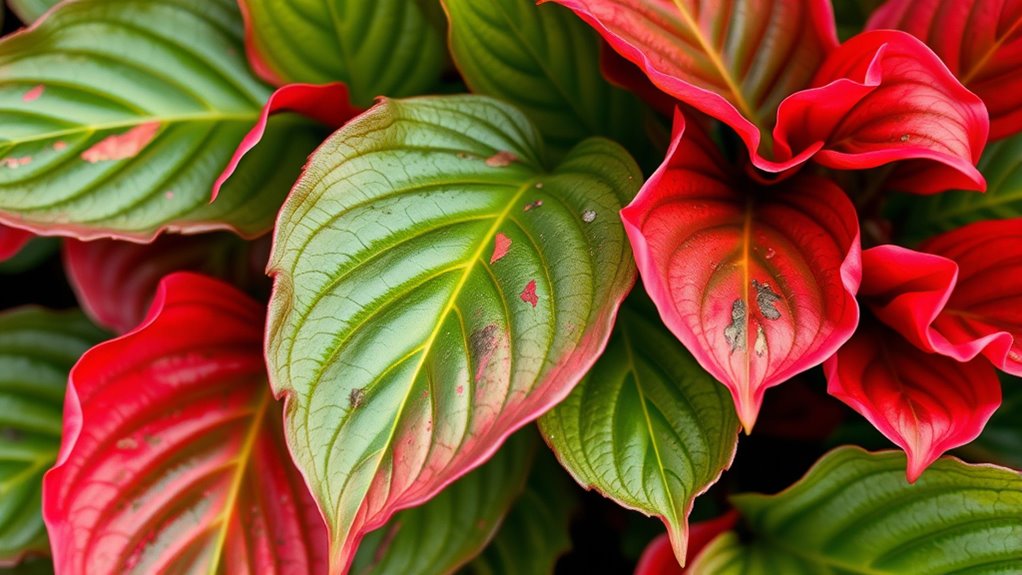
While promoting vibrant red tips is rewarding, it’s equally important to watch for signs that your Photinia may be stressed or diseased. Look for yellowing or browning leaves, which can indicate overwatering, poor drainage, or disease. Curling or wilting leaves may signal inadequate watering or pest issues. Check for unusual spots, lesions, or powdery coatings that could suggest fungal infections. To support plant health, use proper pruning techniques to remove damaged or diseased branches, improving airflow and reducing disease risks. Incorporate soil amendments if you notice poor soil health, such as adding compost or organic matter to enhance drainage and nutrient content. Regularly inspecting your Photinia helps catch problems early, ensuring you can address stress or disease before leaf curl worsens. Additionally, understanding the signs of stress and disease in Photinia can help you take prompt action to preserve its health.
Effective Strategies for Preventing Leaf Curl and Red Tips
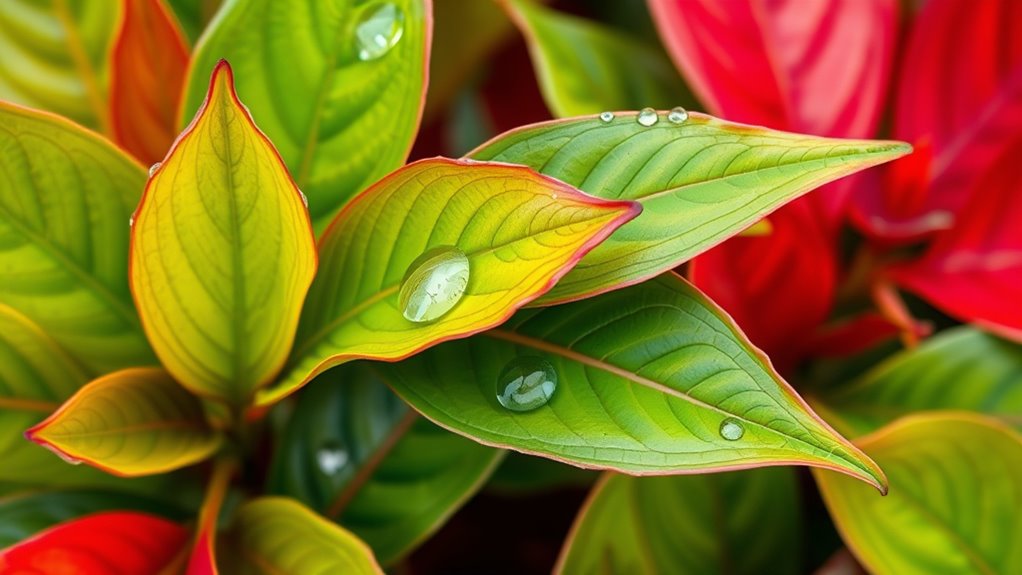
To prevent leaf curl and maintain the vibrant red tips of your Photinia, you should adopt proactive care strategies. Focus on proper pruning techniques to encourage healthy growth and airflow, reducing stress that causes curling. Use soil amendments like compost or organic matter to improve drainage and nutrient availability, strengthening your plant against environmental stressors. Regular watering at the base prevents drought stress, which can lead to leaf issues. Keep an eye on pests and diseases that may worsen red tips or curl. Additionally, avoid over-fertilizing, which can cause excessive growth and weak stems. Incorporating specialized planters can aid in maintaining optimal soil conditions and moisture levels. Proper watering techniques are essential for preventing stress and ensuring healthy foliage. Regularly monitoring your plant’s health and adjusting care practices accordingly can help in preventing leaf curl and red tip problems before they develop.
Treatments and Care Tips to Restore Your Photinia’s Health
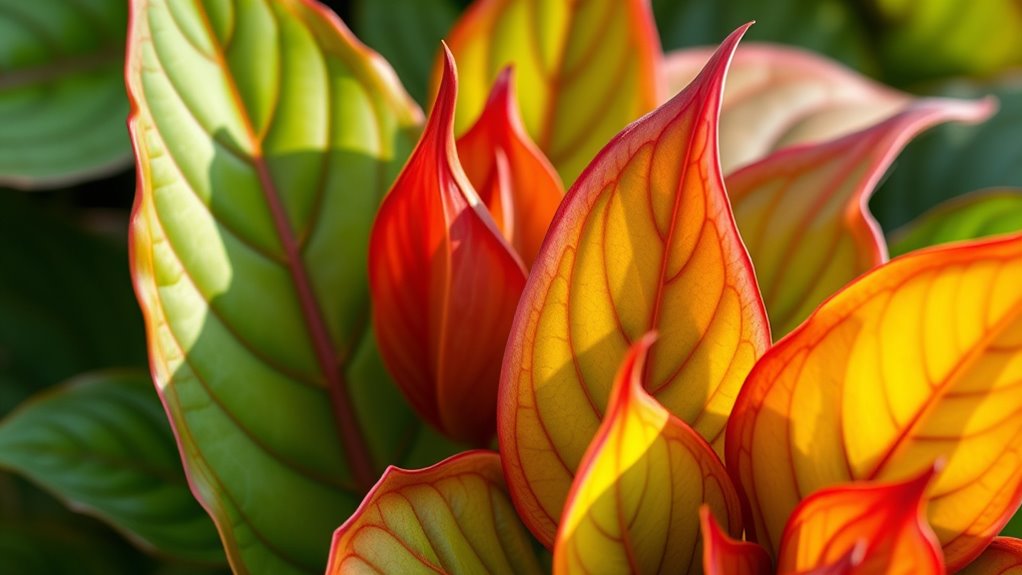
When your Photinia shows signs of leaf curl or red tip decline, prompt treatment is essential to restore its health. Start by using proper pruning techniques to remove affected branches, promoting better airflow and reducing disease risk. Be sure to sterilize your tools to prevent spreading problems. Additionally, consider soil amendments like organic compost or well-draining soil to improve root health and nutrient absorption. These adjustments help strengthen the plant and encourage new, healthy growth. Regular watering is also vital, but avoid overwatering, which can worsen issues. Keep an eye on environmental stressors, and adjust care routines accordingly. Proper soil management can significantly enhance your plant’s resilience. Incorporating appropriate watering practices ensures consistent moisture levels without overwatering, further supporting recovery. Good plant health practices, including monitoring for pests and diseases, can also prevent future problems. By combining targeted pruning and soil improvements, you give your Photinia the best chance to recover and thrive.
Frequently Asked Questions
Can Overwatering Cause Photinia Leaf Curl and Red Tips?
Overwatering can definitely cause leaf curl and red tips on your photinia. When you water too often or the soil doesn’t drain well, roots can get waterlogged, leading to stress and nutrient deficiencies. This disrupts the plant’s ability to absorb water properly and causes symptoms like curled leaves and red tips. To fix this, make certain proper watering habits and improve soil drainage to keep your photinia healthy.
Are Specific Fertilizers Linked to Red Tip Development?
Imagine your Photinia’s vibrant red tips like a painter’s brushstroke—fading with the wrong fertilizer. Certain fertilizers, especially those high in nitrogen, can lead to nutrient imbalances, impacting red tip development. A poor fertilizer impact causes deficiencies in key nutrients like phosphorus or potassium, resulting in curled leaves and red tip fading. Choose a balanced fertilizer tailored for Photinia to guarantee healthy growth and vivid red accents.
How Does Pruning Affect Leaf Curl and Red Tips?
Pruning techniques can markedly influence leaf curl and red tips by promoting healthy growth regulation. When you prune properly, you remove damaged or overgrown branches, encouraging better airflow and reducing stress on the plant. This helps prevent excessive red tips and leaf curl caused by environmental stress or nutrient deficiencies. Regular, strategic pruning maintains the plant’s overall health, supporting balanced growth and minimizing issues like leaf curl and red tips.
Is Photinia Leaf Curl Contagious to Nearby Plants?
You might wonder if photinia leaf curl is contagious to nearby plants. Generally, plant disease caused by leaf curl isn’t contagious like a virus or bacteria, but it can sometimes spread through insect infestation, such as aphids or mites, which transfer the problem from one plant to another. To protect your garden, regularly inspect your plants for pests and keep your plants healthy, reducing the risk of spreading issues.
Can Natural Remedies Effectively Treat Red Tip Problems?
Oh, sure, natural remedies are just magical potions that cure everything, right? In reality, they can sometimes help with red tip problems, but their treatment effectiveness varies. You might try neem oil or insecticidal soap for pests or stress relief, but don’t expect miracles. Always combine natural remedies with proper care, and remember, if problems persist, consulting a professional guarantees your photinia receives the right treatment.
Conclusion
By understanding what causes leaf curl and red tips in your photinia, you can better prevent and address these issues. With a little attention, you might find that giving your plant proper care coincides perfectly with vibrant, healthy foliage. When you watch for signs of stress and act early, your photinia can bounce back just as unexpectedly beautiful as the spring flowers that bloom nearby. Sometimes, a little knowledge is all it takes for nature to surprise you with its resilience.
